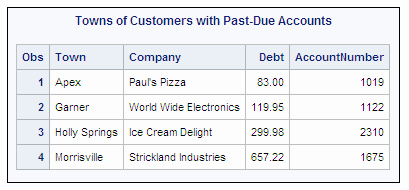SORT Procedure
Example 4: Retaining the First Observation of Each BY Group
| Features: |
PROC SORT statement option: : NODUPKEY BY statement |
| Other features: |
PROC PRINT |
| Data set: | Account |
| Note: | The EQUALS option, which is the default, must be in effect to ensure that the first observation for each BY group is the one that is retained by the NODUPKEY option. If the NOEQUALS option has been specified, then one observation for each BY group will still be retained by the NODUPKEY option, but not necessarily the first observation. |
Details
In this example, PROC
SORT creates an output data set that contains only the first observation
of each BY group. The NODUPKEY option prevents an observation from
being written to the output data set when its BY value is identical
to the BY value of the last observation written to the output data
set. The resulting report contains one observation for each town where
the businesses are located.
Program
proc sort data=account out=towns nodupkey;
by town; run;
proc print data=towns;
var town company debt accountnumber;
title 'Towns of Customers with Past-Due Accounts'; run;
Program Description
Create the output data set TOWNS but include only the
first observation of each BY group. NODUPKEY
writes only the first observation of each BY group to the new data
set TOWNS. If you use the VMS operating environment sort, then the
observation that is written to the output data set is not always the
first observation of the BY group.

